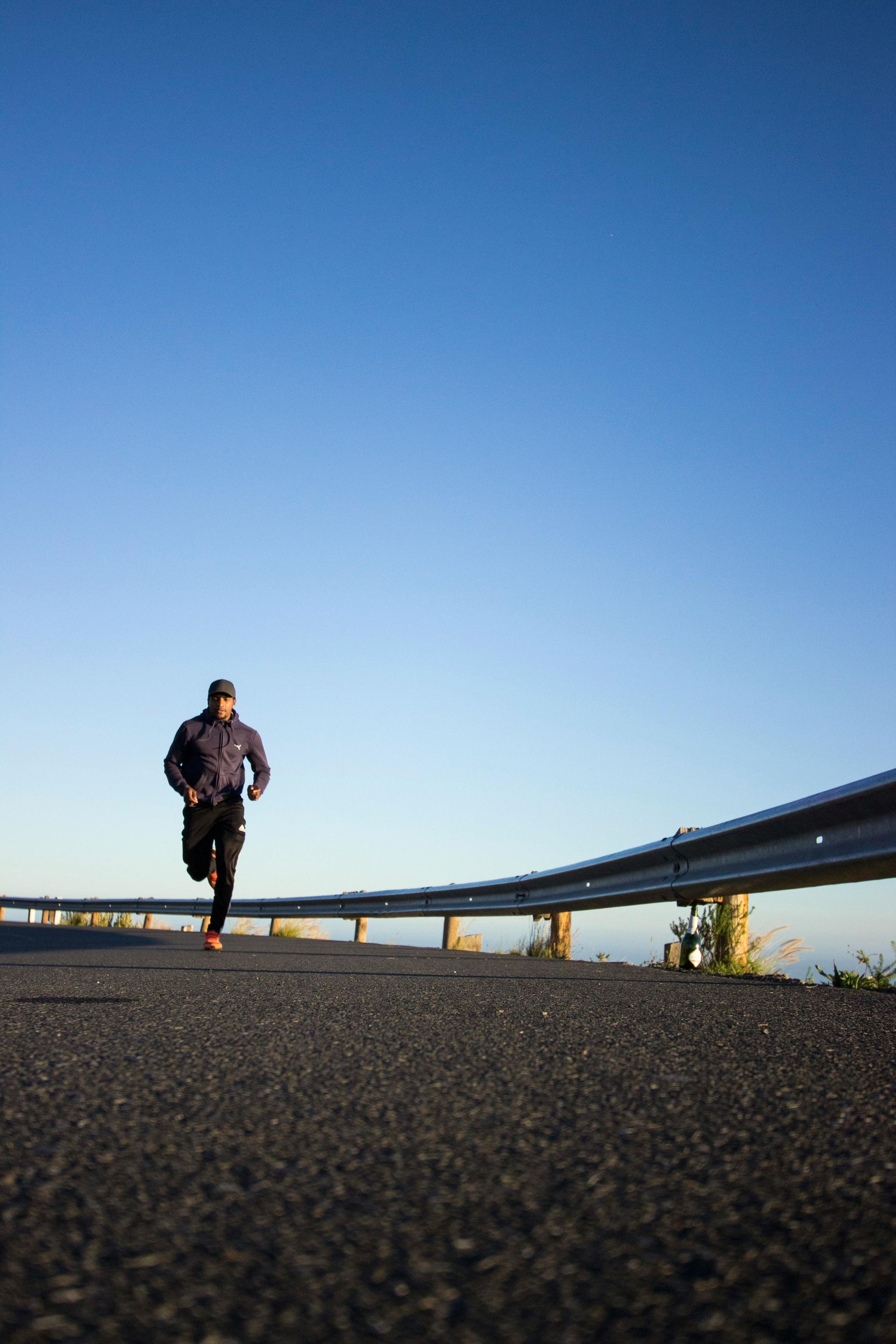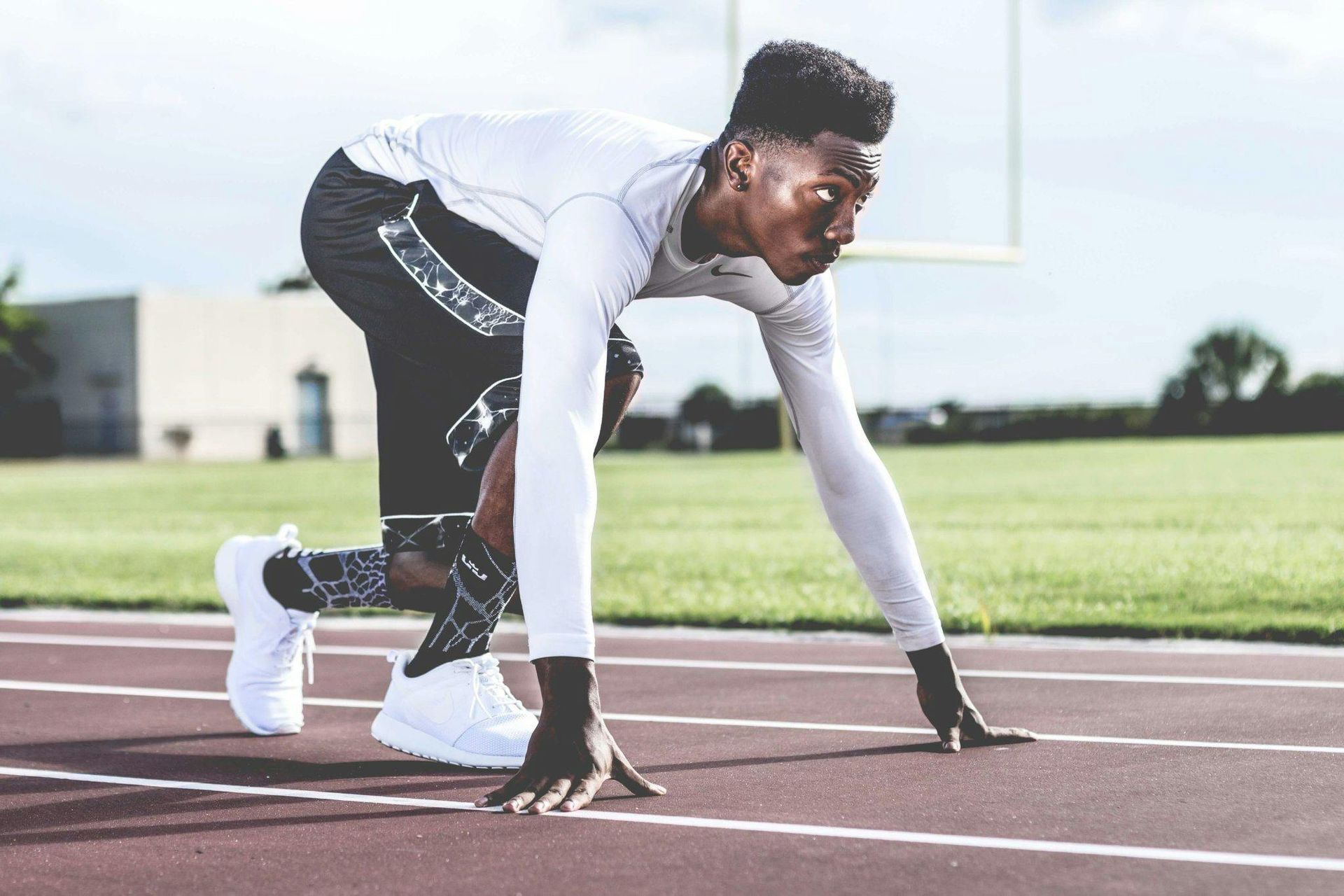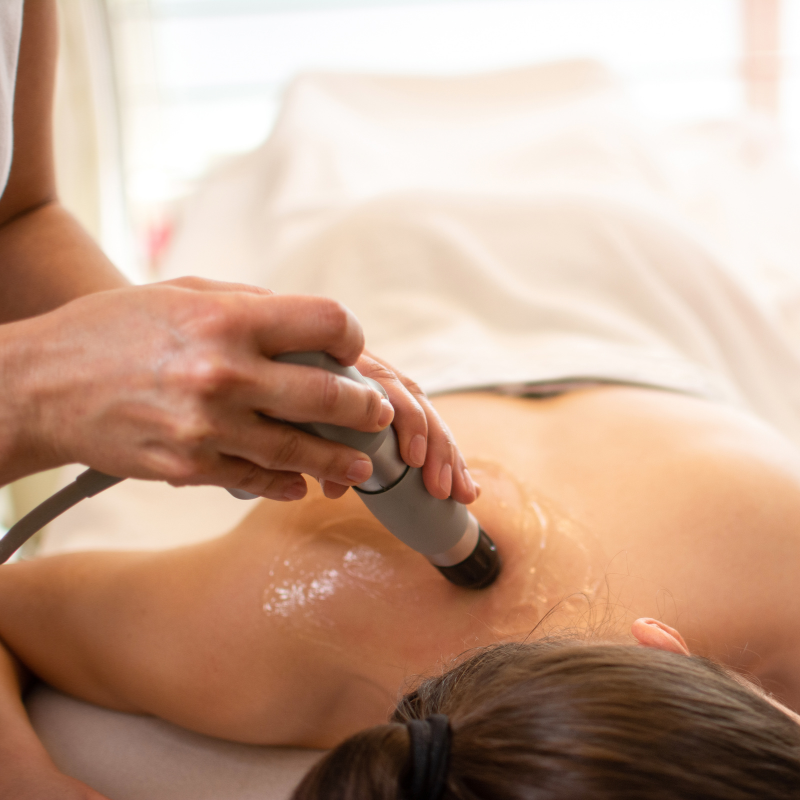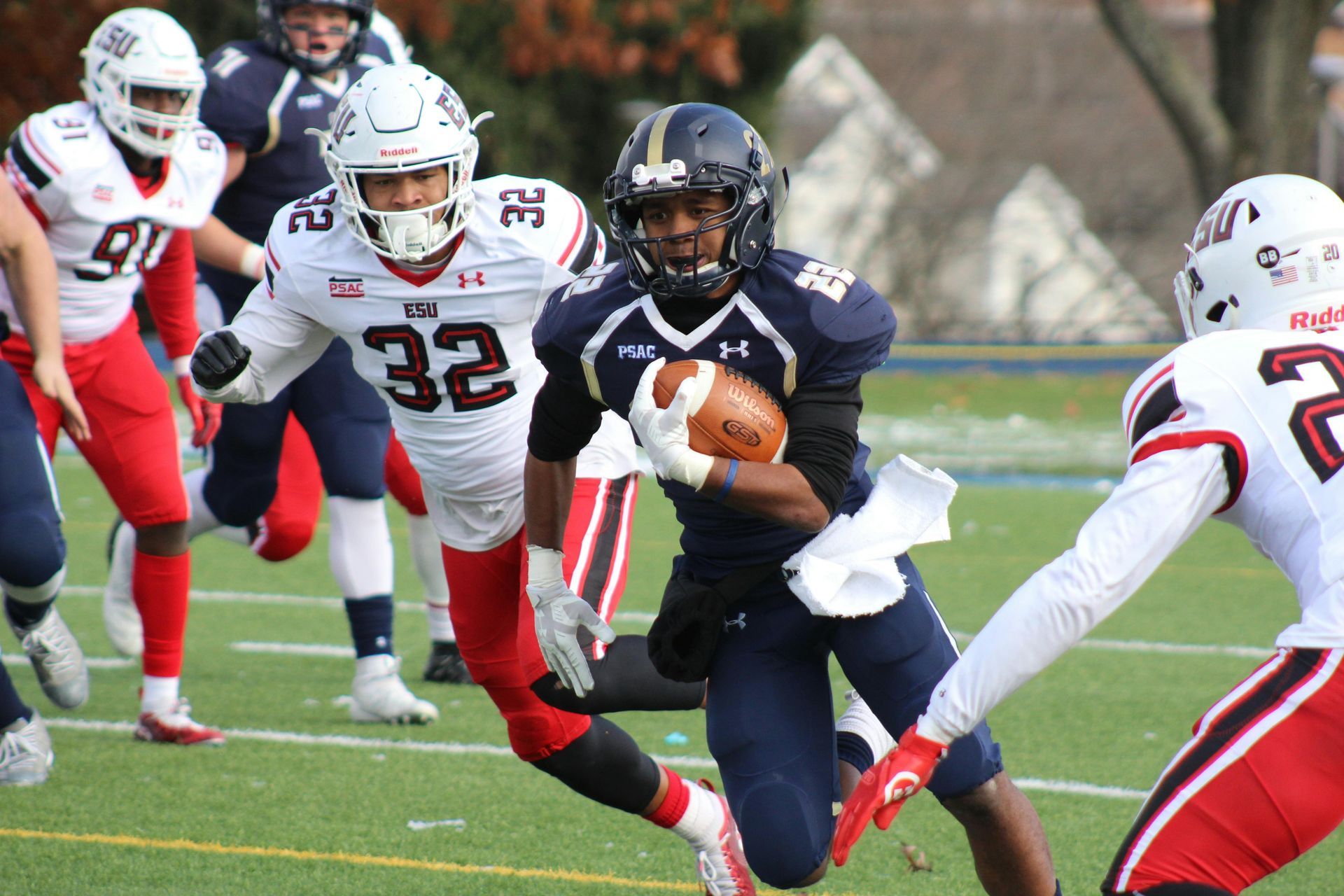Cycling Mechanics
Proper Bike Fit
Proper frame size
The best way to ensure a bike fits you properly is to stand over the frame and see if there is about 2.5-5cm or 1-2 inches of clearance between the bike frame’s top tube and your groin. The graphic below outlines the various parts of a bike frame.
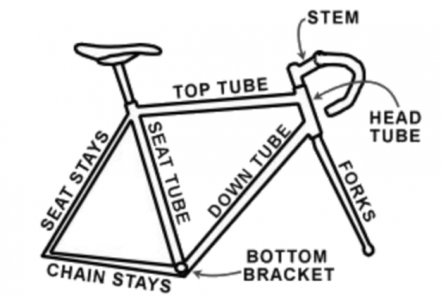

Adjusting the seat’s fore/aft position
For the majority of people, the seat position should be kept level, however, some may find it more comfortable with the nose of the seat angled slightly downwards.
The KOPS Method
Knee Over Pedal Spindle or KOPS is a method used to obtain the perfect bike fit. This method starts with sitting on the bike on a level surface with your foot in the 3 o’clock position on the pedal.
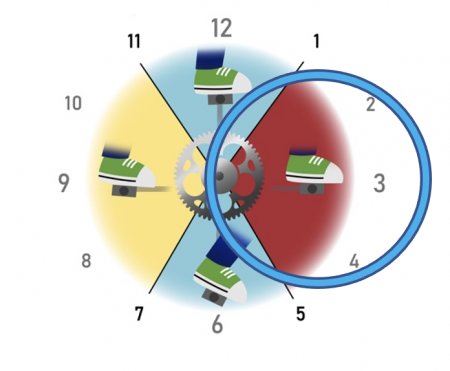
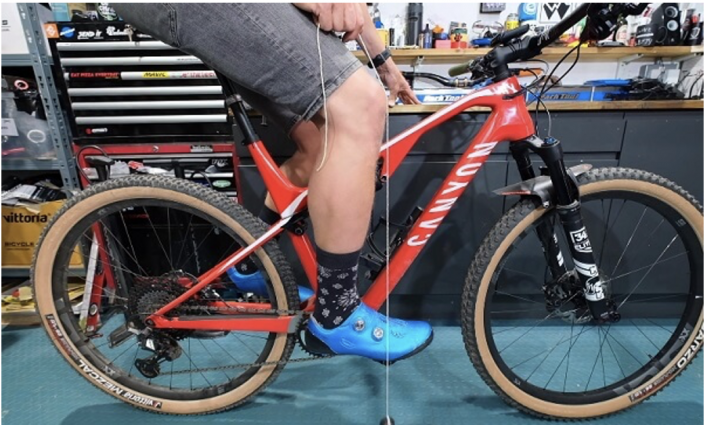
Once in this position, dangle a string with a small weight on the end from just below your knee cap. The string should hang in the middle of the pedal (see picture below as a reference). If this is not the case, adjust the seat forward or backwards until it does settle in the middle.
Setting the handlebar height
Generally, the height of your handlebars should be above the height of your seat for a more upright riding position which will allow for more comfort during your ride. However, the handlebars can also be positioned below the height of the seat for a more aerodynamic forward-leaning performance position.

Pedalling dynamics
Regardless of cycling discipline, all cyclists can reap benefits from improving their pedal stroke. These benefits include injury prevention and improved efficiency and economy. To maximize pedalling economy, cyclists should focus on pedalling in “circles,” not “squares.” This may seem intuitive because the cranks move in a circular motion; however, power is not generated equally through the pedal stroke. Let’s break down the pedal stroke into two simple phases and strategies to improve it.
Phase 1: Power phase
The vast majority of the power is generated from the 12 o’clock to 6 o’clock position, mainly by the hip extensors (glutei) and the knee extensors (quadriceps). Focusing only on the power phase of the pedal stroke will result in a “mashing” or “square” style pedal stroke that is less efficient, less economical and may prematurely fatigue the quads and glutes. There is also activity of the hamstrings during this phase, as they help extend the hip, albeit to a much lower extent than the glutes. Interestingly, during the power phase of the pedal stroke, the calf muscles (ankle plantar flexors) are active but would not be considered significant power-generating muscles. Instead, their role is to contract isometrically to create a rigid lever for the foot to transfer force to the pedal.
Phase 2: Recovery phase
The recovery phase occurs from 6 – 12 o’clock positions. During this phase of the pedal stroke, our knee flexor (hamstrings), ankle dorsiflexors (tibialis anterior) and, to a small extent, hip flexors are active (but not power generating) to ensure a smooth transition back to the beginning of the 12 o’clock power phase.
More serious cyclist will often have special cycling shoes with cleats on the bottom of the sole that locks the cyclist’s foot in place on the pedal. The advantage to cleated cycling shoes is that it allows for a greater transfer of force from the foot to the pedal. However, with their foot firmly secured to the pedal, many cleated cyclists believe that they can and should actively generate power on the upward pull stroke of the recovery phase (6-12 o’clock). Unless you are a track cyclist or quickly accelerating on a breakaway, this upward pull, or “negative toque,” is an ineffective pedalling technique.
We must remember that if one leg is starting the recovery phase of the pedal stroke, the other leg is starting the power phase. The power generated by the opposite glutei and quads overwhelms any collective power contribution of the hamstrings, tib ant, and hip flexors. Therefore, the best strategy is to actively utilize the recovery muscles to “get out of the way” and unload the pedal to facilitate the crank getting back to the top of the pedal stroke.
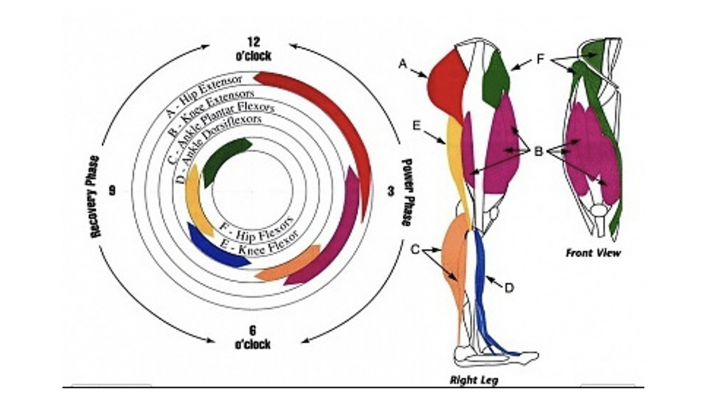
How can I incorporate this information to improve my pedalling?
Pedalling at a relatively high cadence (+90 rpm) makes it challenging to modify the stroke “online.” Therefore, it is helpful to anticipate the two areas of transition between the two phases, the top and bottom of the pedal stroke, and initiate their respective actions early. Think about “kicking” your leg outwards at the top of the pedal stroke and “pulling the heel backwards” at the bottom of the stroke. These simple tricks will ensure that you engage the appropriate muscle groups correctly and facilitate the “pedalling in smooth circles” goal. Another simple on-bike pedalling drill is to ride in a lower than comfortable gear (easy gear) and pedal at a cadence that is 10-15 rpm higher than you usually would. While doing so, your pelvis should remain firmly in contact with the saddle and not bouncing around or listing to one side. Please keep in mind that improving your pedal stroke will not occur overnight. It will take time for your central nervous system, proprioceptors, and muscles to adapt.
Fueling for your ride
Proper fueling is fundamental to any exercise, especially regarding high intensity exercise, endurance, or competitive racing. Ensuring your muscles have adequate energy supplies to complete the given exercise task will ultimately help you prolong time to exhaustion and fatigue while also enhancing performance.
Why is it important to fuel for my ride and what does this mean?
The body has various forms of stores of fuel and substrates to acquire the needed ATP for muscular energy. The two main energy sources in aerobic exercise primarily comes from the oxidation of carbohydrates (glycogen) as endogenous substrates from the liver and muscle in the form of glucose and exogenous sources of readily available carbs acquired through varying forms of gels, liquids and solid food, as well as the oxidation of fats (triglycerides) from adipose tissue in the form of free fatty acids.
For the most part, carbohydrates are the primary energy source for high intensity exercise, while fats are the primary energy source of endurance exercise. However, during prolonged, intense exercise such as that in competitive/distance cycling, energy production becomes highly dependent on carbohydrate-based fuels.
Our bodies have a limited storage of glycogen. As reported by Hawley and Leckey (2015), during prolonged strenuous exercise (greater than 60% VO2max), such as cycling, muscle and liver glycogen stores deplete, dropping blood glucose levels to the point of fatigue. Fatigue will begin to occur at around 70% VO2 max as a result of inadequate carbohydrate energy if in a fasted state. This can lead to hypoglycemic symptoms (i.e., dizziness, confusion, shaking and reduced motor drive) that will ultimately impair performance.
When and how should I be fueling for my ride?
Fueling for rides will look different depending on intensity, duration and frequency. Below is an outline that will include casual cycling and competitive/distance cycling (70km +) fueling.
Casual riding
For casual cycling, proper fueling is still important but is not as tedious as competitive/distance riding. Fueling for casual cycling will incorporate a well-balanced diet consisting of proper carbohydrate, fat, and protein ratios.
A good rule of thumb for daily carbohydrate intake of ~ 45-65% of total calorie intake or ~130g and protein intake of 10-35% of total calories or ~0.8-1g/kg/day to allow for optimal energy levels during any given exercise routine and modality.
Competitive and distance riding
As mentioned previously, due to the finite stores of liver and muscle glycogen in the body, carbohydrate-based energy becomes imperative in distance/competitive cycling which requires more energy for longer periods of time. Thus, we require exogenous sources of carbohydrates before and during exercise to prolong performance by decreasing the drop in blood glucose that would lead to hypoglycemic conditions and fatigue
Pre- ride- sufficient glycogen stores support blood glucose homeostasis
Incorporating a carbohydrate loading regimen is essential to ensure adequate starting glycogen stores are available to fuel your rides to prevent a drop in blood glucose levels and prolong time to exhaustion.
Pre-loading muscle glycogen concentrations in a 1-day carb loading regime (~10g CHO/kg) prior to competitive or distance cycling is sufficient in increasing starting muscle glycogen content.
Furthermore, the ACSM highlights that athletes should be consuming 1-1.4 g/kg carbohydrates every 1-4 hours leading the event.
During – CHO feeding during improves time to fatigue
Glycogen sparing is a term that is used to refer to sparing of liver glycogen stores to prevent glycogen depletion for as long as possible and thus, avoiding exhaustion. Glycogen sparing allows for energy to be available during the later phases of exercise. Glycogen sparing is acquired when exogenous sources (carbohydrates ingested via liquids or foods) of carbohydrates are consumed to maintain adequate blood glucose levels to sustain the high rate of carbohydrate oxidation needed to maintain performance. Consuming multiple transportable carbohydrates (ex. glucose, fructose) in a variety of forms (i.e., carbohydrate mouth wash, gels, liquids, solid food) in the later phases of your ride will encourage glycogen sparing and prolong time to exhaustion.
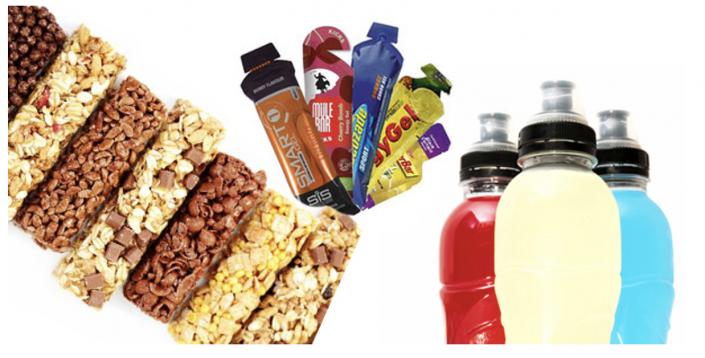
This is a general guideline for exogenous carb consumption for various durations of cycling:
During Brief riding (>45 minutes or 20-30 km): CHO not needed
During endurance exercise (1-2.5 hours or ~50 km): 30-60g of CHO mostly liquid form
During ultra endurance (>2.5-3 hours or >75km): up to 90g of CHO gels, or liquid

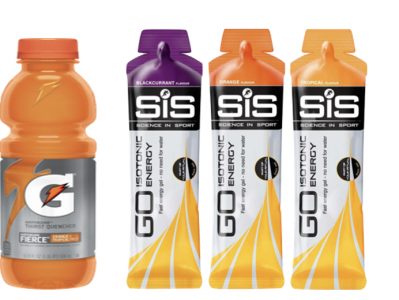
There are different forms of carbohydrates that can be consumed:
The best combination of carbohydrates to improve time during performance is glucose-fructose (sucrose) ingestion as it has the least symptoms of gastrointestinal discomfort as compared to glucose sources. Sucrose can be in the form of drinks, gels and solid food. Drinks and gels are more readily available and easier to consume while riding.
Post ride
Post ride fueling is just as important as pre and during fueling. Consumption of a variety of carbohydrates post exercise is essential to maximize muscle glycogen resynthesis that will allow for adequate restoration of muscle glycogen concentration. For adequate restoration to occur, our bodies need approximately 24-48 hours for repletion.
Refueling after a ride will include 1-1.2g/kg/hr of CHO for the first 4 hours post exercise followed by a return to normal daily fueling regime. This will allow for proper replenishment of glycogen stores and recovery.
Furthermore, protein ingestion post exercise is also important to help repair damaged tissues. For adequate muscle protein synthesis, ~0.24g/kg of protein sources would suffice.
Muscular Balance
Incorporating strength training between rides is a beneficial way to increase your cycling efficiency, improve recovery time and decrease risk of pain and injury. Improving muscular strength, especially in the lower body, is beneficial to increase neuromuscular coordination. Improved neuromuscular coordination of your legs will in turn improve the power phase of the pedal stroke.
Furthermore, exercises that emphasize unilateral movements (single limb movement) such as the single leg deadlift highlighted below increase stability, fixes asymmetries of the lower body and increases muscular balance and coordination to optimize pedal stroke efficiency.
Below are a few movements to incorporate into a strength training routine in addition to your cycling workouts.
Single leg deadlift
- Builds strength in your hamstrings. Optimal hamstring strength is important for cyclists to consider due to the repetitive nature of the sport. The constant flexion and extension of the knee joint could result in strains, sprains or tears if muscular strength and flexibility are not adequate. Furthermore, the single leg deadlift challenges balance, which is key a factor for cyclists to have, while also emphasizing core engagement.
- To perform this move, start with your feet hip width apart. While ensuring you keep your hips square, bend at your knee on one leg slightly while leaning forward until your torso is parallel with the floor and your other leg extends straight behind you. Return to the starting position. Perform this movement in a slow and controlled manner.
- For added challenge, you can perform this move with a kettle bell as shown to further enhance balance and core activation.
- Complete 2-3 sets of 8-12 reps on each leg

Squats
- The major driving muscles during the power phase of a pedalling stoke for cyclists are your glute muscles as well as your quadriceps. The squat is a great compound movement to engage both of these muscles to allow for optimal efficiency and reduce the risk of injury during cycling.
- Start this movement with your feet hip width apart, toes slightly pointed outwards. Brace your core as you begin to lower down until your thighs are parallel with the ground. Return to the starting position.
- The squat can be performed in a variety of ways which include body weight, using dumbbells or a kettlebell, or using a barbell.
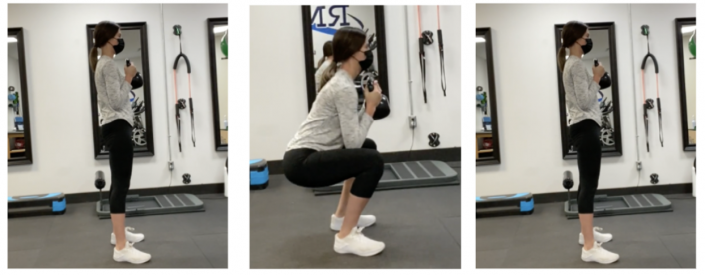
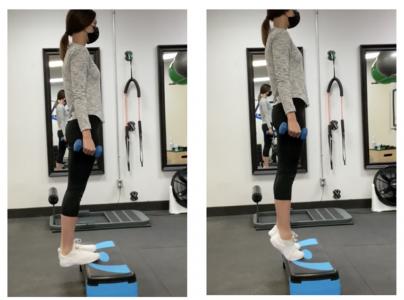
Calf raises
- The calf muscles are also another significant muscle that contributes to pedal stroke during the power phase.
- You can do this movement either on a plat form or on the ground, with or without weights.
If you are experiencing any pain while cycling and would like to speak with one of our physiotherapists to locate the source of the problem, please don’t hesitate to reach out via email (admin@rightmovept.com) or phone (613 384 3222).

